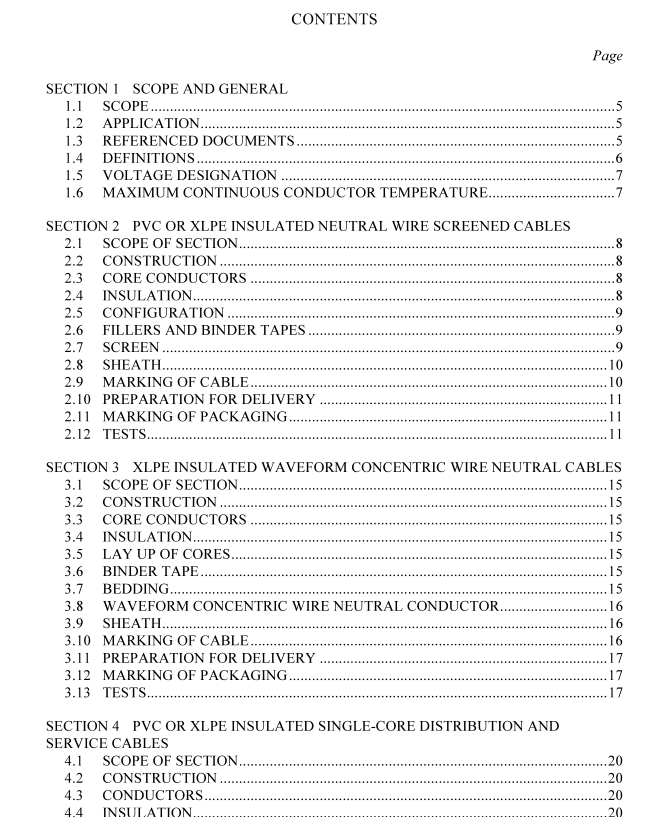AS NZS 4961 pdf download – Electric cables—Polymeric insulated— For distribution and service applications

AS NZS 4961 pdf download – Electric cables—Polymeric insulated— For distribution and service applications
1.4 DEFINITIONS For the purpose of this Standard, the definitions given in the referenced Standards and those below apply.
1.4.1 Approximate thickness A thickness which is neither guaranteed nor checked. It is used, for example, for the calculation of other dimensional values.
1.4.2 Core Active conductor with its insulation but not including any protective covering.
1.4.3 Direction of lay Direction of slope of a core in a laid-up multicore cable or other helically applied cable component. It is right-hand when the slope is in the direction of the central part of the letter Z, and left- hand when the slope is in the direction of the central part of the letter S.
1.4.4 Maximum continuous conductor temperature Maximum temperature at which the conductor of the cable may be operated continuously and is the temperature resulting from the combined effect of the ambient temperature and the current loading on the conductor.
1.4.5 Routine tests Tests made by the manufacturer on each manufactured length of cable to check that each length meets the specified requirements.
1.4.6 Sample tests Tests made by the manufacturer on samples of completed cable, or components taken from completed cable, so as to verify that the finished product meets the design specification.
1.4.7 Type tests Tests made before supplying, on a general commercial basis, a type of cable covered by this Standard, to demonstrate satisfactory performance characteristics that meet the intended application. These tests are of such a nature that, after they have been made, they need not be repeated unless changes are made in the cable materials or design which might change the performance characteristics.
1.4.8 Voltage designation For cables for a.c. systems, the rated voltages U o , U and U m expressed in the form U o /U(U m ), or for cables for d.c. systems, the rated voltage U o — where U o is the r.m.s. power frequency voltage to earth of the supply system or d.c. voltage of the supply system for which the cable is designed. U is the r.m.s. power frequency voltage between phases of the supply system and for which the cable is designed. U m is the maximum r.m.s. power frequency voltage between any two phase conductors for which cables and accessories are designed. It is the highest voltage that can be sustained under normal operating conditions at any time and at any point in a system. It excludes voltage variations due to fault conditions and sudden disconnection of large loads.
1.4.9 Wavelength or length of lay
The axial distance between successive crests of the waveform or turns of the helix formed,as appropriate, e.g. by a core of a multi-core cable, wire of a stranded conductor or screen.
1.5 VOLTAGE DESIGNATION
The rated voltage U o /U(U m ), recognized for the purposes of the Standard is 0.6/1(1.2)kV.
1.6 MAXIMUM CONTINUOUS CONDUCTOR TEMPERATURE
The maximum permissible continuous conductor temperature of cables shall be as follows:
(a) For cables insulated with V-75 or V-90……………………………………………………. 75°C.
(b) For cables insulated with X-90 or X-90UV……………………………………………….. 90°C.
2.1 SCOPE OF SECTION This Section specifies the construction, dimensions and tests for PVC or XLPE insulated neutral wire screened cables intended for use in electrical installations including overhead and underground lines at working voltages up to and including 0.6/1(1.2) kV. Except where otherwise specified, the cables shall comply with the requirements of AS/NZS 5000.1. NOTE: The neutral screen of a 5-conductor cable may be used as a separate earth conductor.
2.2 CONSTRUCTION The cable shall consist of one core, two cores laid parallel or two, three or four cores laid up with fillers (where necessary); V-75, V-90 or X-90 insulated with all the cores surrounded by a helically applied concentric wire outer conductor and sheathed. Pilot cores may be included.
2.3 CORE CONDUCTORS Core conductors shall be of plain or tinned copper or aluminium and shall comply with the appropriate requirements of AS/NZS 1125. Where tinning is provided wires taken from the finished cables need not pass the continuity test for tin plating in AS/NZS 1125.









